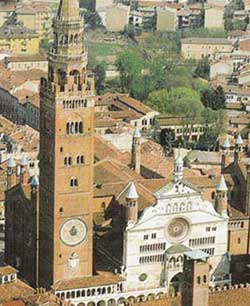|
|
|
 Cremona (Italy)
most famous luthiery town in the world
Sound ideals between middle of 18th century and till ca.1826
Existence of two kinds of violins is apparent from Wolfgang's letter to Leopold, which he wrote on the 6th October, 1777: "…when they Dubreill - pupil of Tartini, and Carl - his youngest son] began to discuss violins for concerts and violins for orchestras, they reasoned very well, and they were always of the same opinion as I". Five years later, when Mozart was 26, in 1782, Paduan luthier Antonio Bagatella published a violinmaking treatise - "Memoir, or Rules for the construction of violins - violas - violoncellos - double basses". He instructed on how to obtain a "silvery voice" or a "human voice". Connoisseur of Mozart P.Lichtenthal mentioned two sound ideals of Mozart's time in his "Dictionary of Music", published in 1826. From the above documents it is apparent that two kinds of violins existed during a few decades, and it was still remembered in the beginning of the 19th century.
 Wolfgang Amadeus Mozart
Bagatella was one of the first and the most famous luthiers who made transformations of the old baroque violins into "classical" instruments. "I adapted proportions of many old violins, working more on old instruments than on instruments which I made myself". According to his Memoirs, he started making violins when he was about 19. On Christmas night, 1748, he discovered the rules, which became his method. This was probably the time, when the first violin modifications of "classical" character took place. It was just before Tartini and Geminiani published their treatises on violin playing (1750 and 1751 respectively). A few years later, in 1756, Leopold Mozart published his treatise. Same year Wolfgang Mozart was born.
Method
The method of Bagatella is a proportional design, in which all violin parts assembled together in a perfect Harmony. He believed that things were not in harmony at HIS time, but they were in harmony in the past and he “discovered” the rules. Thus, to obtain a "human voice" the top of an instrument must have an even thickness. To obtain a "silvery voice" the top must be somewhat thicker in the middle. So when Bagatella was demanded to create a "human voice" he had to make the thickness of the top equal. When a "silvery voice" was demanded - the top had to be left thicker in the middle, and made thinner toward the ribs. In both cases both outline and thicknesses were changed proportionally.
Unknown criteria
We can't know how they distinguished between "human" and "silvery" voices. Many of the “Strads” and other instruments had the tops with an equal thickness. Probably the sound of such instruments was called "human". Guarneri violin, which was in a possession of Paganini, has a top thicker in the middle. Was it called "silvery" at Bagatella's time? Was it called "silvery" even in Paganini's hands? This may remain a question forever - one certain thing is that it was a concert violin for him.
Tartini, Bagatella and Mozart
 Giuseppe Tartini
Mozart’s instruments
Leopold, who took the greatest care about musical education of Wolfgang, furnished him with a few instruments. Originally "baroque", these instruments were modernized in the 2nd half of the 18th century. This is the list of instruments, preserved in the Mozart Museum in Salzburg:
Child Violin (Kindergeige) - in a possession of Mozart Museum since 1896. It is modernized to such an extent that it has lost almost all historical interest.
Violin - with a false label "Jakobus Stainer, in Absam, / prope Oenipotum, 1659. This violin was probably made in Mittenwald in the first half of the 18th century. According to some theories it is that violin, which Mozart used it until 1781, however, there is not enough evidence to assume that this violin ever belonged to Mozart.
Attribution and lack of evidence
The problem with all these instruments is that there is not enough evidence to assume that these instruments indeed were in Mozart’s property. Apart from the above instruments, there are a few instruments of doubtful property and attribution preserved in different collections in Europe.
Related resources:
The contents, views and opinions in this article are those of its author.
|
|
|
|
|
|